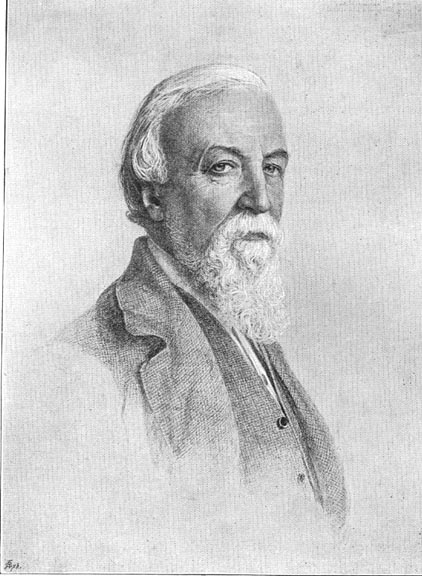
Portrait of Robert Browning, by Frederick Sandys (1829-1904). 1881. Pencil and coloured chalk on grey-green paper. 27 ¼ x 20 ¼ inches (69.1 x 51.4 cm). Private collection. Image courtesy of Christie's. Right click disabled; not to be downloaded.
This portrait shows Browning at the age of sixty-nine as an elderly white-haired and white-bearded man facing right with his head half turned to the spectator. He wears a grey tweed jacket with matching waistcoat. Browning was one of the two greatest poets of the Victorian era, the other being Alfred Tennyson. The portrait was commissioned by George Lillie Craik, a partner in the publishing firm of Macmillan & Co. Browning was not one of Macmillan's authors, his publisher being Smith, Elder & Co., but presumably Browning was a personal friend of Craik's. The portrait was probably drawn by Sandys at Browning's London home, 19 Warwick Crescent, and was completed in November 1881. It was exhibited at the Royal Academy in 1882, no. 1263.
When the portrait was shown at the Royal Academy in 1882 it was largely ignored by the critics. William Michael Rossetti, however, discussed it in his article on the portraits of Robert Browning for The Magazine of Art in 1890, which featured an engraving of the drawing:

Our next portrait, the fine drawing by Mr. Sandys, dated in November, 1881, shows Browning now an old man, for he had attained the age of sixty-nine. It would be difficult to find a face better drawn or more carefully and delicately realized than this, and yet I do not think it is among the likenesses which most decidedly convey to the spectator a vivid idea of the actual man. The face seems to be longer than Browning's (as to this point, one may contrast it with the portrait by Gordigiani), and the expression altogether is more sedate and less transitional than his; for his countenance, even when most in repose, seemed constantly ready to light up at any incentive or suggestion. It was the countenance of a thinker with whom thought and the expression of thought (whether spoken or written) were habitually at one. Mr. Sandys gives us Browning observant, as assuredly he was, but not with that sharpness and that volition in observation which were so peculiarly his, and which were certain to drive a shaft of light into the thing observed. We should not, however, be the less grateful to the artist for leaving us so exact, deliberate, and skilful a record of the moulding and modelling of our poet's lineaments. [249-50]
Browning was frequently portrayed by Victorian artists including portraits by D. G. Rossetti, Thomas Woolner, Frederic Leighton, G.F. Watts, Julia Margaret Cameron, Alphonse Legros, William Blake Richmond, and Carlo Pellegrini. Several of these are featured in the Browning portrait gallery.
The original image on this webpage was of the engraving on the right, immediately above, from the Magazine of Art. This was scanned by George P. Landow. [Click on it to enlarge it. You may use this image without prior permission for any scholarly or educational purpose as long as you (1) credit the person who scanned it and (2) link your document to this URL in a web document or cite the Victorian Web in a print one.]
Bibliography
Elzea, Betty. Frederick Sandys 1829-1904. A Catalogue Raisonné. Woodbridge, Suffolk: The Antique Collectors' Club Ltd., 2001, cat. 4.15, 263-64.
Fine Victorian Pictures Drawings and Watercolours. London: Christie's (November 5, 1993): lot 142, 92-93.
Rossetti, William Michael. "Portraits of Browning." – II. The Magazine of Art XIII (1890): 246-52.
Created 12 January 2017
Last modified 17 August 2025